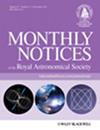发现潮汐宝藏:DECaLS 数据中微弱潮汐特征的自动分类
IF 4.8
3区 物理与天体物理
Q1 ASTRONOMY & ASTROPHYSICS
引用次数: 0
摘要
潮汐特征是星系形成层次模型的一个关键观测预言,包含了大量有关星系性质和历史的信息。LSST 和 Euclid 等现代宽视场巡天将彻底改变对潮汐特征的研究。然而,由于数据量巨大,无法通过目测来识别潮汐特征,因此需要开发自动检测方法。本文将 DECaLS 勘测中的 2000 个星系分为不同的潮汐特征类别:臂状、流状、壳状和弥漫状。我们训练了一个卷积神经网络(CNN),利用这些标签重现指定的视觉分类。在具有潮汐特征的星系数量为 1 : 10 的测试集上进行评估时,我们的网络表现非常出色,在仅有 20 个百分点污染的情况下,分别检索到了 98.7 ± 0.3、99.1 ± 0.5、97.0 ± 0.8 和 99.4^{+0.2}_{-0.6}$% 的臂状、流状、壳状和弥漫状特征的实际实例。修改后的版本可以识别出具有任何特征的星系和不具有任何特征的星系,其准确度、精确度、召回率和 F1 指标分别为 0.981^{+0.001}_{-0.003}$、0.834^{+0.014}_{-0.026}$、0.974^{+0.008}_{-0.004}$ 和 0.900^{+0.073}_{-0.015}$。我们使用梯度加权类激活图谱分析来突出图像上特定分类的重要区域,以验证网络对星系的分类是否正确。这是使用 CNN 将潮汐特征分类到子类别的首次演示,它将为在即将进行的宽视场巡天提供的大量星系样本中识别不同类别的潮汐特征铺平道路。本文章由计算机程序翻译,如有差异,请以英文原文为准。
Uncovering Tidal Treasures: Automated Classification of faint tidal features in DECaLS Data
Tidal features are a key observable prediction of the hierarchical model of galaxy formation and contain a wealth of information about the properties and history of a galaxy. Modern wide-field surveys such as LSST and Euclid will revolutionise the study of tidal features. However, the volume of data will prohibit visual inspection to identify features, thereby motivating a need to develop automated detection methods. This paper presents a visual classification of ∼2, 000 galaxies from the DECaLS survey into different tidal feature categories: arms, streams, shells, and diffuse. We trained a Convolutional Neural Network (CNN) to reproduce the assigned visual classifications using these labels. Evaluated on a testing set where galaxies with tidal features were outnumbered ∼1 : 10, our network performed very well and retrieved a median 98.7 ± 0.3, 99.1 ± 0.5, 97.0 ± 0.8, and $99.4^{+0.2}_{-0.6}$ per cent of the actual instances of arm, stream, shell, and diffuse features respectively for just 20percnt contamination. A modified version that identified galaxies with any feature against those without achieved scores of $0.981^{+0.001}_{-0.003}$, $0.834^{+0.014}_{-0.026}$, $0.974^{+0.008}_{-0.004}$, and $0.900^{+0.073}_{-0.015}$ for the accuracy, precision, recall, and F1 metrics, respectively. We used a Gradient-weighted Class Activation Mapping analysis to highlight important regions on images for a given classification to verify the network was classifying the galaxies correctly. This is the first demonstration of using CNNs to classify tidal features into sub-categories, and it will pave the way for the identification of different categories of tidal features in the vast samples of galaxies that forthcoming wide-field surveys will deliver.
求助全文
通过发布文献求助,成功后即可免费获取论文全文。
去求助
来源期刊

Monthly Notices of the Royal Astronomical Society
ASTRONOMY & ASTROPHYSICS-
CiteScore
9.10
自引率
37.50%
发文量
3198
审稿时长
3 months
期刊介绍:
Monthly Notices of the Royal Astronomical Society is one of the world''s leading primary research journals in astronomy and astrophysics, as well as one of the longest established. It publishes the results of original research in positional and dynamical astronomy, astrophysics, radio astronomy, cosmology, space research and the design of astronomical instruments.
 求助内容:
求助内容: 应助结果提醒方式:
应助结果提醒方式:


